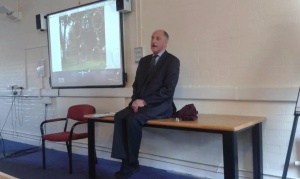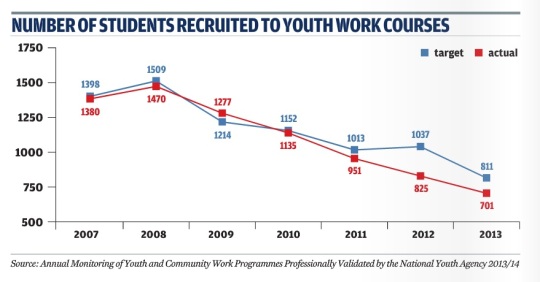I recently attended the ‘100 Years of Youth and Community Work Education’ event hosted by the YMCA George Williams College and supported by Youth & Policy, UKYouth and TAG/PALYCW. The event came about off the back of Tony Jeffs recognising that on the 8th October 100 years ago, what he (and others) recognise as the first proper youth & community training programme came into being. For someone like me who enjoys a bit of Youth Work celebrity spotting this was a star-studded event! The great and the good of our profession and people I’ve been reading and quoting for years were present and ready to divulge their experience.
What was, back when
Tony gave a great account of the roots of Youth and Community education, taking us on a journey from the formation of the YMCA in Springfield, Massachusetts in 1884 when men were required to be trained to meet a need for ‘superintendents’; through incredibly popular courses for ‘play projects’ in 1895 run by Luther and Charlotte Gulick. Then to the London School of Economics’ (LSE’s) short courses that came about from the needs of the ‘National Organization of Girls Clubs’ (now ‘UK Youth’) and then the more formalised 20 day training for them when the organisation needed structural fortification. At the time, we’re told, days started with prayer at 9.30am and finished at around 10pm after the evening club had finished – that’s a working day that probably resonates with people today!
At last on 8th October in 1915 the full 5 term course entitled ‘Education of Girls Club Workers’ (I think I caught that properly…) was formed with the assistance the formidable Louise Creighton.
The various courses stopped and started over subsequent years but eventually, from 1935, became a consistent feature of the educational landscape in its various guises.
The Albemarle Years
Alan Gibson and Tom Wylie, through a bit of a backwards and forwards discussion gave us workforce development post-1960 following the social revolution of the ‘teenager’. Lady Albemarle’s report (1960) gave us a formalised platform to start seriously training professionals into the youth workforce.
Oversubscribed by 3 applications to each place, a brand new course based at the ‘National College for the Training of Youth Leaders’ in Leicester, produced over 600 qualified youth workers over the subsequent 5 years.
One of the things I found interesting on the back of this discussion was one of the views at the time (coming from the Albemarle Report) that a primary need of this new generation of teens was “to see and be seen”. This meant, pragmatically, that youth centres being built at the time were very much open plan, for this reason. It helps to explain the layout of my local youth club building – the 67 Centre in Brighton, named for the year it was built. Anyway, I digress.
By 1982 there were 11 full time course producing 350 graduates per annum. By 1991 there were 60 routes to qualification with 1000 graduates per annum. More recently we have seen graduate numbers in decline as illustrated by the chart below, published by Children & Young People Now in October 2015.
In 2011, the Education Select Committee’s Review of Services for Young People said:
The low priority afforded to continuing professional development of the youth workforce is concerning, in particular the fact that, according to the last audit conducted by the National Youth Agency in 2008, some 33% of local authorities spent nothing at all on it (p.48).
Indicative of this decline are the figures on the uptake of JNC courses in Youth Work that the National Youth Agency (NYA) has recently shared. In 2008 (a recent high) 1,470 people were recruited onto JNC Youth Work courses – today that number stands at just 674, representing a 55% drop from its lofty heights – or an average of 12% fewer students enrolling per year, each year since 2008. Between 2012/13 and 2013/14 the number of JNC courses on offer has dropped from 57 to 51, representing a loss of just over 10% of our courses.
Don’t forget the ‘Community’ bit…
Marg Mayo (Goldsmiths’ College) was able to take us through the evolution of Community Work and particularly its development since the 60s alongside post-war social upheaval and spurred on by Gulbenkian Reports in ’68 and ’73. The professionalisation of Community Development Work has been contentious though, in particular the UK Association of Community Workers saw it more as promoting elitism that would be at odds with its values – not totally dissimilar to discussions the youth sector has had recently about its own professional status.
The social action component of Community Work seems to be as relevant as ever, borrowing from Gramsci, Alinsky and Freire. Its evolution with the use of the internet means a greater numbers of people have easy access to the necessary information and communication media to spark revolutions from the comfort of their own home.
We were implored to consider how we place community work within Youth Work courses, in particular being asked to:
- Set it in the wider context
- Promote the social action component
- Engage with critical social, political sciences e.g. the neoliberal agenda
Parting wisdom from Marg asked us to think in particular about:
- Critical reflection on the changing concept of ‘community’ itself – for instance the importance of diaspora communities
- How to work with formal structures and social movements in solidarity
- Taking account of changing relationships between state, the market and civil society
- Supporting communities to learn and research for themselves, then reflect on the research.
It was also observed that “students need digital competencies” in this day and age, with the advent of social media and its ability to communicate causes and mobilise campaigns at the click of a button.
Youth Work is dead
Mark Smith was invited to answer the question “Does Youth and Community Work Training have a future”. His short answer was “no”. The way he arrived at that had a few people feeling deflated by the end. His presentation, to me, felt as though he was delivering the proverbial ‘shit sandwich’ (AKA ‘the feedback sandwich’) but without the crusts.
His argument was asserted via three crises:
- Economic – the neoliberal, globalised economy has no psychology or accountability – it’s a chaotic science but his predictions saw a personal debt and housing ‘bust’ so, according to Mark, we cannot rely on any increase in spending any time soon plus general doom and gloom.
- Political – the failing nation state oligarchy, centralisation and the hollowing out of democracy, more power to fewer people, target driven work = more doom and gloom.
- Ecological – We’ve seen massive population growth twinned with an ageing population alongside global warming = even more doom and gloom.
General outlook = loads of doom and plenty of gloom
Smith recognised and promoted the changes from traditional ‘Youth Work’ and ‘Youth & Community Work’ course names to those that are more marketable, such as ‘Social Pedagogy’. The idea being that people will see it in ACAS searches and associate it with the popular ‘Social Work’ courses to join in larger numbers. It is also the prevailing catch-all term in European research around what us Youth Workers do. A criticism levelled at ‘Youth Work’ as a term is that it doesn’t describe the process in the same way that ‘Community Development’ or ‘Community Organisation’ does. He went as far as to say that the key texts he developed for the profession under the umbrella of ‘Youth Work’ had been the equivalent of flogging a dead horse. So you can see why some people felt peeved!
Lastly
The day was rounded off with a panel discussion on the future of Youth and Community Work Education where we expanded into the future of the profession generally – including some input from myself on the Institute for Youth Work. Panellists were Shelley Marsh, Jon Ord, Keith Popple, Sue Robertson and Jane Melvin. Another interesting part to the conversations held were about the impact measurement question – its links with the youth education sector I’ve previously discussed here.
Then onto the wine and nibble reception hosted by TAG/PALCYW, a lovely chance to catch up with people and chat on the topics of the day – and of course toast to the next 100 years of Youth and Community Work Education!



